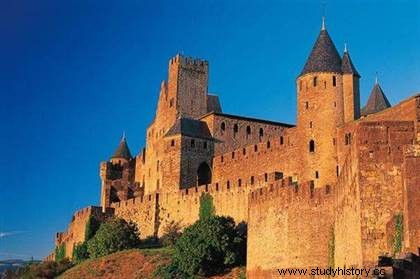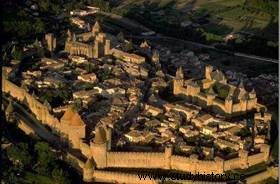 Classified as a UNESCO World Heritage Site, the medieval city of Carcassonne is a remarkable and unique example of a fortified city, with its castle, its towers and its long and powerful ramparts. The city has been the subject of exceptional restoration campaigns since the 19th century, mainly led by Viollet-Leduc .
Classified as a UNESCO World Heritage Site, the medieval city of Carcassonne is a remarkable and unique example of a fortified city, with its castle, its towers and its long and powerful ramparts. The city has been the subject of exceptional restoration campaigns since the 19th century, mainly led by Viollet-Leduc .
Carcarsonne, from prosperity to decline
Iron Age oppidum turned Roman colony, Carcassonne owes its good fortune to trade, as does neighboring Narbonne. Located at a crossroads of peoples and civilizations, Carcassonne was in turn Visigothic (Septimania), then Muslim (Ommeaydes from Spain) before coming under Frankish influence at the end of the 8th century. In the Middle Ages, it was a strategic stronghold on the Franco-Aragonese border. Fortifications are regularly carried out there, in particular by Louis IX, who definitively integrates it into the kingdom of France.
 Rarely disturbed or besieged, the place gradually lost its strategic importance, especially after the Treaty of the Pyrenees which moved in Roussillon the border between France and Spain. The fortified city was gradually abandoned by its inhabitants in favor of the suburbs of the lower town. In the 18th century, it became a miserable and outlying district. The roofs are dilapidated, the walls are cracked, the walls are used as stone quarries by the inhabitants... The church loses its title of cathedral in 1802 in favor of that of Saint-Michel located in the lower town.
Rarely disturbed or besieged, the place gradually lost its strategic importance, especially after the Treaty of the Pyrenees which moved in Roussillon the border between France and Spain. The fortified city was gradually abandoned by its inhabitants in favor of the suburbs of the lower town. In the 18th century, it became a miserable and outlying district. The roofs are dilapidated, the walls are cracked, the walls are used as stone quarries by the inhabitants... The church loses its title of cathedral in 1802 in favor of that of Saint-Michel located in the lower town.
The Restoration of Carcasonne
It is a local scholar, Jean-Pierre Cros-Mayrevieille, who does everything possible to save his city. In 1840, the Saint-Nazaire basilica was classified as a historical monument. After a visit by Prosper Mérimée, then Inspector General of Historic Monuments, he called on Eugène Viollet-Leduc in 1843 to restore it. It was through the Saint-Nazaire basilica that the architect first intervened in Carcassonne in 1844. He surrounded himself with a team of masons, master glassmakers and sculptors. The operations are directed on site by the Carcassonnais Guiraud Cals, because the architect comes once a year, gives directives and leaves on his departure details of execution in sufficient number for the campaign in progress. The western facade is rebuilt, the stained glass windows, the pillars of the nave, the buttresses and the masonry of the choir are renovated. Then comes the restoration of the Narbonnaise gate, the Saint-Nazaire gate, the fortifications, then the towers.
 Contested during his lifetime, the architect had his own vision of restoration:"Restoring a building is not is not to repair or redo it, it is to restore it to a complete state which may never have existed at a given time”. His choices are therefore sometimes hazardous and risky. In Carcassonne, he does not hesitate to substitute slates for the original tiles and to accentuate the point of the roofs...
Contested during his lifetime, the architect had his own vision of restoration:"Restoring a building is not is not to repair or redo it, it is to restore it to a complete state which may never have existed at a given time”. His choices are therefore sometimes hazardous and risky. In Carcassonne, he does not hesitate to substitute slates for the original tiles and to accentuate the point of the roofs...
Bibliography
- Carcassonne:History and Architecture, by Jean-Pierre Panouille. Editions Ouest-France, 2011.
- The City of Carcassonne, by Eugène Viollet-le-Duc. Editions Cairn, 2011.
To go further
- Historic fortified city of Carcassonne (Unesco)
